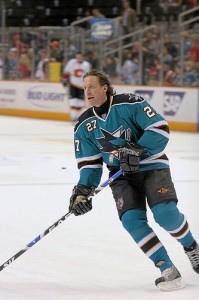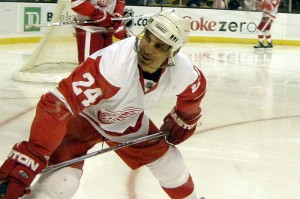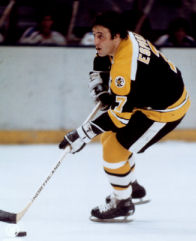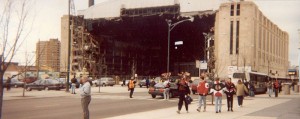Jim Neveau, Blackhawks Correspondent
As the season draws near for the Chicago Blackhawks, and they hit the ice against HC Davos and ZSC Zurich before that, it feels appropriate to once again contemplate how far this franchise has come in such a short amount of time.
After all, it was a mere four years ago that this team was having trouble drawing over 15,000 fans a night. Going to a game at the United Center was, to be honest, a boring experience, sprinkled with poor hockey and the occasional chance at seeing a great player in an opposing team’s sweater.
As we all know, things have improved significantly, and the Hawks are quickly becoming one of the tougher tickets to get in a town full of tough to get tickets. With the Bulls, Cubs, and Bears routinely selling out, the Blackhawks have established their own niche in the market. They’ve gone from the doldrums of a half full arena to selling out every home game last season and drawing over 1,000,000 fans for the first time in team history.
Obviously, credit for this resurgence goes to men like Rocky Wirtz, who got home games on television to sell the product, and John McDonough, who brought the Winter Classic to Chicago in a game that became the most watched NHL regular season contest in 34 years.
We aren’t here to talk about the team’s resurgence, however. Instead, as is normal for a Chicago fan to do, we are here to discuss what the team has done to piss people off over its long history. It has been said that you never appreciate what you have until it’s gone, and for the folks who frequented Chicago Stadium for the second half of the 20th century, that certainly was the case.
Now, here are the “bottom” five worst moments in the history of the Chicago Blackhawks
Number Five: Jeremy Roenick being traded to the Phoenix Coyotes
Jeremy Roenick exploded onto the scene with the Blackhawks during an era that also saw the emergence of other fantastic stars like Eddie Belfour and Chris Chelios. He had a stretch of four straight seasons that saw him score over 40 goals, including back to back 50 plus goal campaigns in 1991-92 and 92-93.

Roenick also put up some incredible postseason numbers, including an 11 goal performance in the 1990 playoffs, and a 12 goal total in the 1992 playoffs. Needless to say, he was a force to be reckoned with during his time with the Hawks.
Then, on August 18th, 1996, that all changed. Roenick, in a cost-cutting move, was dealt to the Phoenix Coyotes for Alexei Zhamnov and Craig Mills. His production slowly declined during the next few seasons, but he managed to combine a nearly point a game average with over 100 penalty minutes in 4 consecutive seasons with the club.
Meanwhile, Zhamnov never scored more than 23 goals in a Hawks uniform, and missed 59 games in his final season with the club. Mills made very little impact as well.
The biggest contribution, according to some, that Zhamnov ever made to the franchise was that he netted Colin Fraser for the Hawks when he was traded to the Flyers.
Number Four: Chris Chelios wearing the dreaded Red Wings sweater
Chelios was a player who bled for Chicago. Not only was he born in the city, but he was a tough-nosed, hard scrabble player who could be counted upon not only to set up a goal, but also to get into a fight to protect a teammate.
In his nine seasons with the team, Chelios racked up 92 goals and 433 total points. He also had a huge amount of penalty minutes, tallying 1495 of them over that stretch. These totals rank him among the all-time leaders of the franchise, and he played in eight All-Star Games to boot. He also captained the 1998 US Olympic Hockey team in Nagano.

Even after all of these accolades, and accomplishments, and even in the face of his being a hometown son, the Hawks decided that it would be a great idea to trade their captain to their archrivals, the Detroit Red Wings on March 23rd, 1999.
Yes, Cheli was 39 years old at the time, but he continued to produce for his new mates with the Wings. He played on two more Olympic teams, including captaining the 2006 team in Torino, and he won two Stanley Cups in Detroit, a feat he never accomplished in Chicago. He also led the league with a +40 in the 2001-02 season.
Needless to say, the sight of Chelios wearing a Red Wings jersey was something that burned in the brains of many Chicago fans, and really set the tone for the team’s fall from grace at the end of the century and into the new millennium.
Number Three: The James E. Norris Era
Ever heard of a conflict of interest? For instance, politicians get in trouble all the time for lobbying for taxpayer dollars to go to a company, and it is later revealed that said politician owns stock in or has relatives that work for that company. These politicians generally face ridicule, being voted out of office, or even prosecution for this unsavory act. Happens in Chicago all the time, as a matter of fact.
Well, take this example with politicians, and imagine if your favorite hockey team was owned by the owner of your archrivals. Well, in the case of the Blackhawks, that nightmare scenario was the reality of the James E. Norris Era.
For eight years after the death of original team owner Frederic McLaughlin, the Black Hawks (as they were known at the time) were owned by longtime team president Bill Tobin. Tobin, however, was merely a pawn for the owner of the Red Wings, Mr. Norris. Norris was the Hawks’ landlord, having purchased Chicago Stadium in 1936.
During the ownership of Tobin, and under the watchful puppeteer Norris, the Hawks were a terrible team, essentially serving as a minor league affiliate of the Red Wings. Every trade that was made between the two squads ended up benefitting Detroit substantially. During this era, the Hawks were the model of futility in the league, and were until Norris died in 1952.
Granted, the team snatched Glenn Hall and Ted Lindsay in future years from the Wings, but the damage had been done. For the eight years after World War II, the Hawks were a joke.
Number Two: The Esposito-Hodge-Stanfield Trade
The Roenick trade may have caused some rifts between fans and the Hawks, but the original bad trade, the organizations Brock-for-Broglio, occurred in 1967, the year the NHL expanded.
In a deal with the Boston Bruins, the Blackhawks traded Phil Esposito, Ken Hodge, and Fred Stanfield to Boston in exchange for Pit Martin, Jack Norris, and Gilles Marotte.

Granted, Martin was a star and part of the legendary MPH line (along with Dennis Hull and Jim Pappin), but the three players the Bruins got in the deal helped the team to win two Stanley Cups, and Esposito ended up winning heaps of awards and set many scoring records.
It may not have been a completely lopsided deal, but it essentially handed the Bruins a couple of Cups, as well as prevented the Hawks from having the depth to win one.
Number One: May 18th, 1971
The 1970-71 Blackhawks captivated the city of Chicago. With legends like Mikita, Hull, Esposito, and Magnuson (a murderer’s row that all have their jersey numbers retired by the franchise), the team exploded for a record of 46-17-15, and an easy first place finish in the new West Division.
The team also earned the adoration of the Chicago sports world. As Chet Coppock puts it in his excellent book “Fat Guys Shouldn’t Be Dancin’ at Halftime”:
“As much as I like Patrick Sharp and Jonathan Toews, they just will never see the love that was dished out by Chicago to the ’71 Hawks. Won’t happen. We’re talking one-of-a-kind love affair. “
The Hawks beat the Rangers in the NHL semi-finals, and faced the vaunted Montreal Canadiens in the final. After six grueling games, the teams engaged in a Game 7 at the old Chicago Stadium. With the ice in poor shape and the atmosphere hot and humid, the game was sloppy from the start, but the Hawks jumped out to a 2-0 lead.
Then, it all started to unravel. After a Bobby Hull shot bounced off the crossbar, the Canadiens finally broke through, scoring on Tony O and making the game 2-1. Tony Esposito said “we should have won it. If Bobby doesn’t hit the crossbar, we lead 3-0 and it’s over.”

Unfortunately, the Hawks were unable to make anything happen the rest of the game, and the Canadiens took over and won it 3-2 in front of a capacity crowd. The team was sullen to say the least, and as Esposito put it, “I didn’t say a word after the game. I didn’t have to.”
The team reached the finals again the next season, but the result was the same: defeated at the hands of Montreal. After that, Hull jumped ship and headed to the WHA, and the team gradually dismantled one of the most talented cores that the NHL has ever seen.
It all should have been gravy that night at Chicago Stadium, but as so many other Chicago sports teams have done, the Hawks broke the hearts of a city.
Great read Jim!
I’ll be linking to this article on Paint It Blackhawks ( ) in the not so distant future!